Abstract
Greater New Orleans is surrounded by wetlands, the Mississippi River and two lakes. Excess rain can only be drained off with pumping systems or by evaporation due to the bowl-like shape of a large part of the city. As part of the solution to make New Orleans climate adaptive, green infrastructure has been implemented that enable rainfall infiltration and evapotranspiration of stored water after Hurricane Katrina in 2005. The long-term efficiency of infiltrating water under sea level with low permeable soils and high groundwater tables is often questioned. Therefore, research was conducted with the full-scale testing method measuring the infiltration capacity of 15 raingardens and 6 permeable pavements installed in the period 2011–2022. The results show a high variation of empty times for raingardens and swales: 0.7 to 54 m/d. The infiltration capacity decreased after saturation (ca 30% decrease in empty time after refilling storage volume) but all the tested green infrastructure met the guideline to be drained within 48 h. This is in contrast with the permeable pavement: only two of the six tested locations had an infiltration capacity higher than the guideline 10 inch/h (254 mm/h). The results are discussed with multiple stakeholders that participated in ClimateCafe New Orleans. Whether the results are considered unacceptable depends on a number of factors, including its intended purpose, site specific characteristics and most of all stakeholder expectations and perceptions. The designing, planning and scheduling of maintenance requirements for green infrastructure by stormwater managers can be carried out with more confidence so that green infrastructure will continue to perform satisfactorily over the intended design life and can mitigate the effects of heavy rainfall and droughts in the future.
1. Introduction
Climatic extremes such as flooding, droughts and heat stress are expected to occur more frequently in the years to come. Due to the high-density development and high percentage of impervious surfaces, urban densely populated areas in particular are becoming vulnerable to climate change. The increase in impervious surfaces leads to an increase in stormwater runoff volume [1,2]. Peak flow rates can be reduced by implementing green infrastructure (GI), a Sustainable Urban Drainage System (SuDS) and nature-based solutions (NBS) that are typically designed to reduce runoff through infiltration [2,3,4]. Several factors impact the hydraulic performance of GI such as different geohydraulic circumstances (soil type and groundwater), side-slope length, composition filter media, soil moisture content, type of vegetation, type of maintenance [5], implementation and design. Previous studies show that the performance in general can be influenced by (human) failures in the design, implementation and maintenance of swales [2,6]. There are several international studies that determined the variation in mean volume reduction in GI [7,8,9,10,11,12,13,14], high variations in peak flow rate reductions and infiltration capacity [15]. However, little is known about the long-term infiltration (un)saturated capacity of GI under sea level such as New Orleans with low permeable soils and high groundwater tables.
1.1. New Orleans
The agglomeration of Greater New Orleans is surrounded by water on virtually all sides: wetlands to both the east and west, Lake Borgne to the east, Lake Pontchartrain to the north and the Mississippi River to the south. The proximity to the Gulf of Mexico, combined with the fact that half of the urbanized land in New Orleans lies below sea level results in great challenges for flood management [16]. New Orleans’ districts have a bowl-shaped topography, which implies that all precipitation that falls within this region must be removed through pumping or evaporation. The vulnerability with regards to coastal and pluvial flooding became apparent when Hurricane Katrina overtopped levees and left an estimated 1833 casualties along with billions of dollars in damage [13,17]. More recently, heavy rain storms such as the one on 5 August 2017 have frequently overwhelmed the city’s drainage infrastructure [18]. Climate change will result in an increasing intensity of rain storms over the next century [19]; the annual precipitation in New Orleans already increased by roughly 20% during the twentieth century [18].
The New Orleans water management system is equipped with an elaborate network of underground drainage pipes, which are emptied into Lake Pontchartrain by pumping stations (Figure 1). Even though New Orleans’ pumping stations belong to the most powerful in the world, ageing infrastructure and heavy subsidence in low-lying neighborhoods have made drainage increasingly difficult [17]. Therefore, the city has been engaged in programs to introduce alternative ways in dealing with stormwater [20,21] and strongly encourage the installation of green infrastructure in new developments through legislation and post-construction runoff controls with local building codes for New Orleans [22]. The ‘Dutch Dialogues’ workshops in 2008 brought together Dutch and American experts to reimagine New Orleans’ flood management and eventually led to the Greater New Orleans Urban Water Plan. This framework plan provides a new paradigm in stormwater management principles and introduces the concept of the water assignment in New Orleans [23]. After Katrina, green infrastructure was implemented (Figure 2) such as raingardens, swales, permeable pavement and bio retention cells.
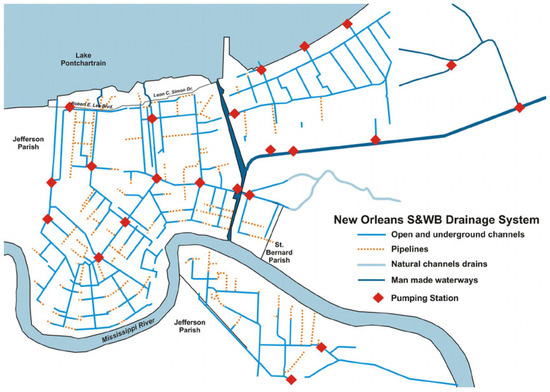
Figure 1.
New Orleans pumping stations and drainage system [16].
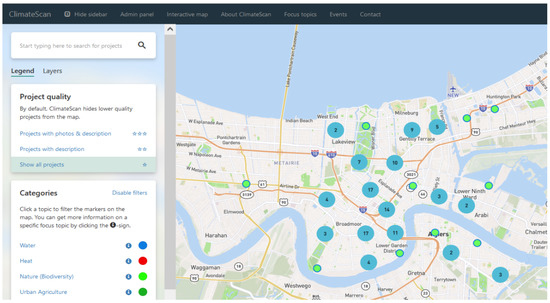
Figure 2.
Green infrastructure mapped in New Orleans at public and private properties [source: climatescan.org accessed on 20 December 2022].
The international open source citizen science platform ClimateScan [24] shows over 200 locations where GI is implemented on private and public areas (Figure 2) but little information can be found on the infiltration capacities of this GI.
1.2. Soil, Geology and Groundwater Situation
The infiltration characteristics of green infrastructure largely depends on the permeabilities of the soil and deeper subsurface and the groundwater level before and during rainstorms. The largest area of New Orleans possesses a clay soil (Figure 3) with a low permeability. However, the topsoil area (approx. the zone above the mean lowest groundwater level) green infrastructure is constructed as engineered gardens with high permeable soil and in some cases additional drainage. Figure 3 illustrates the test locations sites with the soil (lithology) characteristics showing that most of the green infrastructure is situated in regions with low permeable soil (clay).
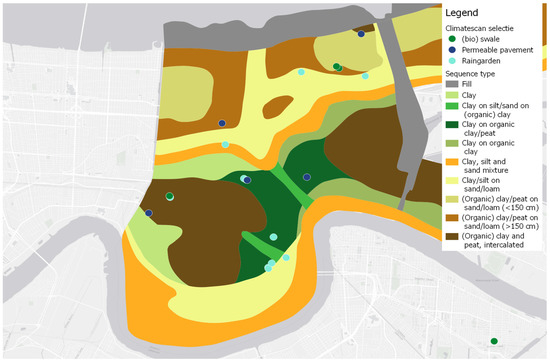
Figure 3.
Lithological sequence type map constructed based on borehole information. Source Digital Elevation Model: Deltares (2022).
Stormwater managers and other stakeholders want to have an understanding of the design, construction and maintenance of green infrastructure. Guidelines [22] dictate that green infrastructure should be drained within 48 h (Figure 4) as communicated on signs at the green infrastructure. Permeable pavement has a different guideline: permeable pavement should show a minimum of 10 inches/hour according to stakeholders.
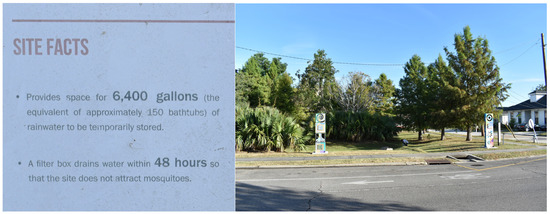
Figure 4.
(Left) Sign at green infrastructure site ‘drains water within 48 h so the site does not attrack mosquitos’ source: https://www.climatescan.nl/projects/7399/detail, accessed on 20 December 2022. (Right) Test location with signs on the right of the inlet.
Stormwater managers need an understanding of the hydraulic performance of green infrastructure under the specific circumstances of low permeable soil and high groundwater tables. Therefore, this study set out to answer the following simple research question: Does green infrastructure meet the guidelines in New Orleans?
To answer this question, several site locations were selected with stakeholders (see acknowledgements) and data about these locations were gathered (location, year of construction etc.). Surprisingly, no inclusive map was available of all green infrastructure (most stakeholders have mapped their own sites but no inclusive map with public and private locations regardless of the ownership was available). In addition, stakeholders could not provide any open access monitoring results which stimulated the stakeholders to participate in this climatecafe New Orleans and learn new monitoring skills. There are many methods to study the efficiency of green infrastructure [25]; this research utilized innovating participative testing methods for New Orleans (full-scale testing method) to answer the research question in more detail: Which variation of the (un)saturated infiltration capacity can be expected under conditions with low permeable soil and high groundwater tables (under sea level)?
2. Materials and Methods
A variety of infiltration test procedures have been utilized in the past to measure infiltration rates accurately in the field. A large variation in the range of infiltration rates can be expected. There is no single standard agreed method for monitoring the surface infiltration of raingardens, permeable pavement and swales. Most studies in the United States are based on single- or double-ring infiltrometer tests: ATSM C1781 [26] and NCAT permeameter methods [27]. Measuring the infiltration rate through a small area of the pavement double- and single-ring infiltrometer tests should represent the infiltration rate of the total area of green infrastructure. Using small areas for testing (the area of the inner ring of the ATSM C1781 is 0.0707 m2) could lead to erroneous results. A number of studies have demonstrated a high degree of spatial variability between different infiltration measurements performed on the same pavement location [28,29]. Spatial variations in infiltration capacity can be effectively averaged-out by inundating a larger area of pavement with the full-scale infiltration testing (FSIT) method [30,31] to determine the surface infiltration rate of green infrastructure in New Orleans as performed on more than 250 existing permeable pavement installations, raingardens and swales.
Full-Scale Method
For the case study in New Orleans, some single infiltrometer tests were performed for comparison with the full-scale infiltration test where (a large part of) the volume of green infrastructure was filled and the emptying time (falling head) was measured. During the experiments, stakeholders were invited in the international ClimateCafe setting [32] to raise awareness and capacity building and obtain information about the lifespan of GI such as year of construction, design criteria and maintenance.
Most green infrastructure such as swales and raingardens has a confined storage volume which can be filled without any additional constructions to prevent water leaving the storage volume during the FSIT (Figure 5 left). For the testing of permeable pavement, a confined space was made by making a dike of sandbags (Figure 5, right). For the FSIT in New Orleans, a fire hydrant was used if available or a water basin of 110 L was used.

Figure 5.
(Left) FSIT at raingarden Milne (test number G14, Table 1). (Right) FSIT at permeable pavement after building a confined space with plastic and sandbags.
Self-logging, wireless pressure transducer loggers (TD-Diver) were used in the FSIT for measuring and recording the infiltration capacity of green infrastructure. The TD-Diver is a submersible datalogger for real-time water level monitoring using a pressure sensor when submerged at a fixed level under the water surface. The pressure sensor measures the equivalent hydrostatic pressure of the water above the sensor to calculate the total water depth. The logger autonomously measures pressure and temperature and records them in its internal memory. This Diver with a 104 g weight features a stainless steel casing with a 22 mm diameter. The TD-Diver can store a maximum of 72,000 measurements (date/time, pressure and temperature) and measures water height with an accuracy of ±0.5 cm H2O and resolution of 0.2 cm H2O [33]. At the lowest point of the green infrastructure, the loggers are set. The water height loggers log the data in internal memory continuously monitoring the static water pressures at those locations. To verify the water height loggers, additional measurements were used: time-lapse photography and underwater camera (movies available at ClimateScan.org) and hand measurements. At some locations, water quality and soil quality measurements were obtained and continuous loggers were installed for follow-up research. At some locations, drillings of the soil were made to obtain more information on the soil type and groundwater table (Figure 6).

Figure 6.
Measurement with loggers and rulers (left) and additional information by drilling the soil (right).
The test locations of the green infrastructure were selected with the stakeholders and all available information was gathered (Table 1 and Table 2).

Table 1.
Test locations green infrastructure (raingardens) with information gathered during climatecafe New Orleans.

Table 2.
Test locations permeable pavement with information gathered during climatecafe New Orleans.
3. Results
In Table 3, the results of the infiltration capacity are given for all tests.

Table 3.
Overview of test results of raingardens, swales and permeable pavement.
The single-ring infiltration tests show a high variation in infiltration rates. For permeable pavement, all infiltrometer tests indicate a higher infiltration capacity than a full-scale infiltration test of the same facility. As discussed, the single-ring infiltrometer test will not be representative for the total area since it is based on the infiltration rate through a small area of the green infrastructure.
The GNOF permeable pavement (test 18) shows an infiltration capacity of 194 m/day (falling head single-ring infiltrometer test). Permeable pavement at SUNO (Southern University at New Orleans) shows a high difference between infiltrometer (61 m/day) and full-scale test on another location (8.7 m/day).
Using small areas for testing could potentially lead to results that are not representative. When using the infiltrometer rings, it should be repeated several times to obtain an average insight into the infiltration capacity. Since spatial variations in infiltration capacity are averaged out by inundating a much larger area of green infrastructure during the FSIT instead of the single-ring infiltrometer test, only the results of the FSIT tests will be referred to in the next paragraphs.
3.1. Green Infrastructure Infiltration Rates
The water height curves in time for the tested green infrastructure are given in Figure 7 showing high variation in infiltration capacity.
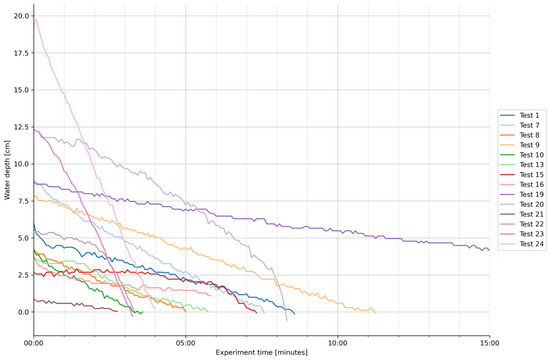
Figure 7.
Water pressure green infrastructure curves during full-scale testing (falling head).
The average infiltration rate in mm/h for each test site was generated by linear regression analysis with the best fit for the transducer readings from each site. As expected, we observed a high variation. Test number 19, which corresponds with the Aurora raingarden (Table 3), shows infiltration rates of roughly 3 m/day. In contrast, well-drained raingardens near Lafitte Greenway show infiltration rates of over 50 m/day, meaning that the water only had to pass a thin layer of soil before reaching a drain underneath transporting the water without much delay to the stormwater drainage system.
The FSIT test simulation shows the unsaturated infiltration capacity (Figure 8). Repeating the test led to a reduction in infiltration rates. This was performed at the Aurora raingarden (test 19) with the lowest test result of 3.3 m/day showing a reduction to 2.37 m/d after filling up the storage a second time which is a reduction to 72% of its initial unsaturated infiltration rate. This iteration was also carried out at test 20, 23 and 24 showing percentages in the same order as 54%, 72% and 79%.
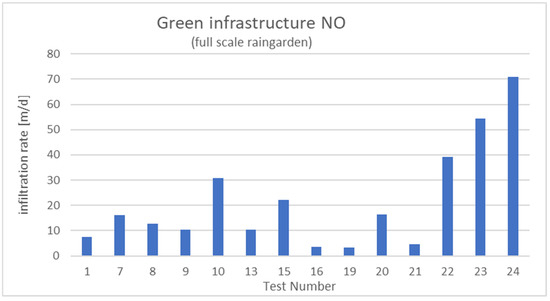
Figure 8.
Full-scale test results of green infrastructure in New Orleans.
3.2. Permeable Pavement Infiltration Rates
The difference in infiltration rates for permeable pavement range from 0.7–8.72 m/d measured at the oldest and newest locations constructed in 2011 and 2019 (without any maintenance after construction). Figure 9 shows the test results of permeable pavement where the age (when known) is also noted.
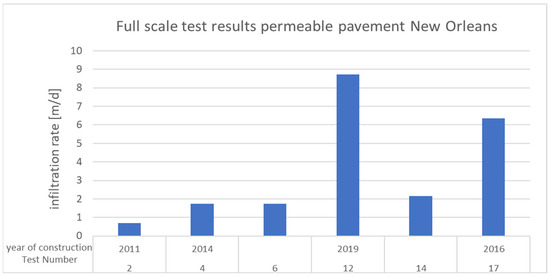
Figure 9.
Full-scale test results of permeable pavement in New Orleans.
For test 17 (construction year 2016), the initial infiltration rate of 6.35 m/d decreased to 4.11 m/d (test 2), 3.9 m/d (test 3) and 2.79 m/d (test 4). This corresponds with reductions to 65%, 61% and 44% of its initial value (Figure 10).
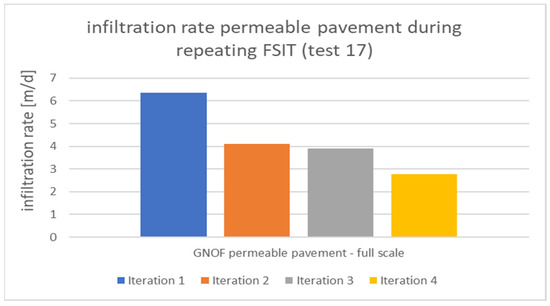
Figure 10.
Infiltration rate permeable pavement during repeating FSIT (test 17).
A significant reduction in infiltration rates between the unsaturated and saturated tests can also be seen in other international research locations where the FSIT method was used to test green infrastructure implemented in low permeable soil and high groundwater tables, showing similar reductions in infiltration rate to initial unsaturated rate ranging from 52% to 77% [34,35].
The oldest tested permeable pavement installation at the City Park Administration building (test 2) shows the lowest initial infiltration capacity of 0.7 m/day. Test no. 4, 6 and 14 show a similar infiltration rate of roughly 2 m/day. Without repeating the tests on these locations, we can expect lower infiltration rates in rainy periods.
In the literature, a high variation in infiltration capacities can be found with higher and lower infiltration capacities than found in this study with the range from 0.7 to 8.72 m/d (constructed in 2011 and 2019, both tested in 2022). A lower infiltration capacity of 0.264 m/d and higher capacity of 144 m/d was found in one study on pervious concrete cores from eight different parking lots measured with a ring infiltrometer [36]. Measurements at newly constructed Permeable Interlocking Concrete Pavement (PICP) can show infiltration capacities up to 432 m/d, pervious concrete 264 m/d and porous asphalt 86 m/d [27]. More comparable to the study in New Orleans, another study showed infiltration rates of PICPs and crushed stone in the order of 2.5 and 2.3 m/d, concluding that infiltration rates decreased over time due to fine particle clogging [37] as another study in The Netherlands (using the FSIT method and with most of the 39 test locations under sea level) showing results from 0.84 -41 m/d with a median value of 4 m/d [31].
4. Discussion
Some of the types of green infrastructure in this study were of a similar age and construction type but show a large variation in infiltration rates, surprising some of the stakeholders that visited the FSIT during ClimateCafe New Orleans. Potential reasons for the variations in performance of the permeable pavements include differences in pavement laying processes and maintenance (sweeping), different types of bedding aggregates (differences in mix design, compaction) variation of groundwater levels (and moisture content in bedding aggregate), watershed characteristics and surrounding soil type (Figure 3) and the size of the paving joints (Figure 11). These differences have affected infiltration rates through the paving surface. As previously discussed, research found that construction mistakes in green infrastructure may affect surface infiltration rates, and this could also be a reason for the differences [2]. Clogging can be local due to preferential runoff flow routes that drag sediments to particular places or will reduce the infiltration rates of permeable pavements over time [28,29,38,39] and not all of the six pavements tested in this study were of the same age. Differences can be seen in the results of the full-scale test in infiltration rates due to differences in the degree of clogging due to age (Figure 9). A reduced infiltration capacity can also be caused by a decrease in void space through the use of the pavement such as compression from traffic loading and deformation (reduction in air voids) of the asphalt pavement under heavy loads [40].
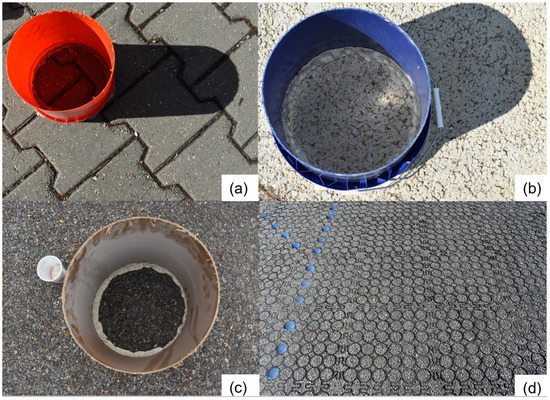
Figure 11.
Permeable pavement variants (paver spacing and joint material) in New Orleans during testing. (a) Impermeable concrete interlocking pavers; (b) porous concrete; (c) porous asphalt; (d) plastic grid pavers (not tested in this study).
Variation of groundwater levels and moisture content in bedding aggregate can influence the infiltration capacity. There is no data on groundwater levels at the test locations [16], but during the period of testing (17–22 October 2022), the conditions were dry. Prior to the test, during September and early October, New Orleans received a total of 46 mm (1.82 inches) of rainfall. Compared to the average climate during this period, September 2022 was exceptionally dry. A few days before testing, some rainfall occurred, but the pre-conditions of the topsoil before testing showed the topsoil was dry. Over the testing period, no additional rainfall occurred (see Figure 12).
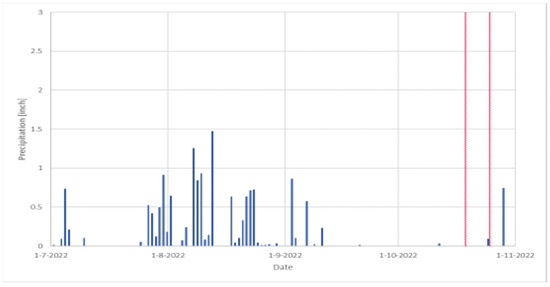
Figure 12.
Rainfall prior and before testing, period between red lines is the testing period (source: NOAA-NCEI, Lakefront Airport [41]).
The repeating of the test shows that the infiltration rate of the permeable pavement installation is affected by pre-wetting. Multiple infiltration tests performed at other locations [42] also show the reduction in (un)saturated infiltration rates with an average reduction rate of 37% (ranged from 27% to 48%). This shows that a reduction in runoff volumes and the infiltration rate of permeable pavements will decrease during periods of frequent rainfall and significant long-term implications for stormwater management. The infiltration capacity of green infrastructure may be significantly overestimated if only unsaturated infiltration capacity test results are used in computer models.
The infiltration rates of four out of six pavements tested in this study were below the guideline recommendation of 10 inch/h (254 mm/h, 6 m/d). This suggests that these pavements may now be due for maintenance to restore their infiltration capacity.
All test results of the raingardens and bioswales show that these infiltration rates meet the guideline of drainage within 48 h even when saturated infiltration capacity test results are used as design input, the infiltration capacity may be sufficient. However, some raingardens drain fast to the existing stormwater drainage system to have the desired impact on the storage and infiltrating water to mitigate effects of heavy rainfall and drought. In addition, minor challenges with green infrastructure have been discussed with possible improvements during the testing (Table 4) that can benefit the performance of green infrastructure in New Orleans.

Table 4.
challenges and possible improvement to green infrastructure.
5. Conclusions
In this study, over 200 climate adaptive measures have been mapped that have been constructed to store and infiltrate stormwater after Hurricane Katrina in 2005. With stakeholders, 22 locations were selected for research. The full-scale infiltration testing method (FSIT) was applied in this study to determine the variation in the long-term hydraulic performance of green infrastructure in New Orleans situated partly under sea-level with high groundwater tables and low permeable soil. The results from this study show that all tested swales and raingardens empty their storage volume within 48 h under (un)saturated conditions. The results of the long-term efficiency of permeable pavement is less encouraging since the guideline of a minimum of 10 inch/h infiltration capacity was not met for four of the six research locations. Previous research focused on unsaturated infiltration rates; the results of the FSIT show that in a rainy period, the unsaturated infiltration rate can be lowered by a factor 0.5 after another rainfall event. These differences in (un)saturated infiltration rate have also been determined in comparable international research with FSIT to show a high variation in infiltration capacity between unsaturated and saturated infiltration rates. Therefore, the infiltration capacity in rainy periods may be significantly overestimated if the unsaturated infiltration capacity is used as the design input for computer models.
Improvements are suggested for the design, construction and maintenance of green infrastructure in New Orleans. The provided checklist in this paper can help several stakeholders with the implementation and maintenance of green infrastructure so that these climate adaptation measures will continue to perform satisfactorily over their intended design lifespan and mitigate the effects of heavy rainfall and droughts in the future.
Author Contributions
Conceptualization, F.B.; methodology, F.B.; software, D.R.; validation, D.R., R.S. and F.B.; formal analysis, D.R.; investigation, D.R., R.S. and F.B.; resources, F.B.; data curation, D.R.; writing—original draft preparation, F.B.; writing—review and editing, R.S. and F.B.; visualization, D.R.; supervision, F.B.; project administration, R.S.; funding acquisition, R.S. All authors have read and agreed to the published version of the manuscript.
Funding
This research was funded by City of New Orleans (supported with a grant of the National Disaster and Resilience Competition) and by SIA, grant number SVB/RAAK.PUB07.015 project ‘Groenblauwe oplossingen, kansen en risico’s’ (Green Infrastructure: changes and challenges).
Data Availability Statement
All locations and footage of the testing can be found on the open source platform climatescan.org as stated tin this article.
Acknowledgments
We thank the following organizations for their contribution to the field collection of the data and host our field experiments: City of New Orleans, Sewerage & Water Board of New Orleans, New Orleans Redevelopment Authority, New Orleans City Park, Greater New Orleans Foundation, Dana Brown and Associates, Inc., Waggonner & Ball and Groundwork New Orleans.
Conflicts of Interest
The authors declare no conflict of interest.
References
- Fletcher, T.D.; Andrieu, H.; Hamel, P. Understanding, Management and Modelling of Urban Hydrology and Its Consequences for Receiving Waters: A State of the Art. Adv. Water Resour. 2013, 51, 261–279. [Google Scholar] [CrossRef]
- Ballard, B.W.; Wilson, S.; Udale-Clarke, H.; Illman, S.; Scott, T.; Ashley, R.; Kellagher, R. The SUDS Manual; CIRIA: London, UK, 2017; ISBN 978-0-86017-697-8. [Google Scholar]
- Fletcher, T.D.; Shuster, W.; Hunt, W.F.; Ashley, R.; Butler, D.; Arthur, S.; Trowsdale, S.; Barraud, S.; Semadeni-Davies, A.; Bertrand-Krajewski, J.-L.; et al. SUDS, LID, BMPs, WSUD and More—The Evolution and Application of Terminology Surrounding Urban Drainage. Urban Water J. 2015, 12, 525–542. [Google Scholar] [CrossRef]
- Barrett, M.E. Comparison of BMP Performance Using the International BMP Database. J. Irrig. Drain. Eng. 2008, 134, 556–561. [Google Scholar] [CrossRef]
- Winston, R.J.; Al-Rubaei, A.M.; Blecken, G.T.; Viklander, M.; Hunt, W.F. Maintenance Measures for Preservation and Recovery of Permeable Pavement Surface Infiltration Rate—The Effects of Street Sweeping, Vacuum Cleaning, High Pressure Washing, and Milling. J. Environ. Manag. 2016, 169, 132–144. [Google Scholar] [CrossRef]
- Vollaers, V.; Nieuwenhuis, E.; van de Ven, F.; Langeveld, J. Root Causes of Failures in Sustainable Urban Drainage Systems (SUDS): An Exploratory Study in 11 Municipalities in The Netherlands. Blue-Green Syst. 2021, 3, 31–48. [Google Scholar] [CrossRef]
- Rushton, B.T. Low-Impact Parking Lot Design Reduces Runoff and Pollutant Loads. J. Water Resour. Plan. Manag. 2001, 127, 172–179. [Google Scholar] [CrossRef]
- Deletic, A. Modelling of Water and Sediment Transport over Grassed Areas. J. Hydrol. 2001, 248, 168–182. [Google Scholar] [CrossRef]
- Wang, J.; Meng, Q.; Zou, Y.; Qi, Q.; Tan, K.; Santamouris, M.; He, B.-J. Performance Synergism of Pervious Pavement on Stormwater Management and Urban Heat Island Mitigation: A Review of Its Benefits, Key Parameters, and Co-Benefits Approach. Water Res. 2022, 221, 118755. [Google Scholar] [CrossRef]
- Langeveld, J.G.; Liefting, H.J.; Boogaard, F.C. Uncertainties of Stormwater Characteristics and Removal Rates of Stormwater Treatment Facilities: Implications for Stormwater Handling. Water Res. 2012, 46, 6868–6880. [Google Scholar] [CrossRef]
- Rodak, C.M.; Jayakaran, A.D.; Moore, T.L.; David, R.; Rhodes, E.R.; Vogel, J.R. Urban Stormwater Characterization, Control, and Treatment. Water Environ. Res. 2020, 92, 1552–1586. [Google Scholar] [CrossRef]
- Lin, Z.; Yang, H.; Chen, H.; Ouyang, X.; Liu, Z. Comparison of the Decontamination Performance of Three Permeable Bricks: Adsorption and Filtration Experiments. Polish J. Environ. Stud. 2020, 29, 3225–3233. [Google Scholar] [CrossRef]
- Koritz, A.; Sanchez, G.J. Civic Engagement in the Wake of Katrina; U OF M DIGT CULT BOOKS: Ann Arbor, MI, USA, 2009; ISBN 9780472116980. Available online: https://www.press.umich.edu/923684/civic_engagement_in_the_wake_of_katrina/?s=description (accessed on 20 December 2022).
- Nguyen, N.P.T.; Sultana, A.; Areerachakul, N.; Kandasamy, J. Evaluating the Field Performance of Permeable Concrete Pavers. Water 2022, 14, 2143. [Google Scholar] [CrossRef]
- Davis, A.P.; Traver, R.G.; Hunt, W.F.; Lee, R.; Brown, R.A.; Olszewski, J.M. Hydrologic Performance of Bioretention Storm-Water Control Measures. J. Hydrol. Eng. 2012, 17, 604–614. [Google Scholar] [CrossRef]
- Nougues, L.; Stuurman, R. Groundwater Drainage in New Orleans. H20 Water Matters 2022, 36–39. [Google Scholar]
- Adams, V.; van Hattum, T.; English, D. Chronic Disaster Syndrome: Displacement, Disaster Capitalism, and the Eviction of the Poor from New Orleans. Am. Ethnol. 2009, 36, 615–636. [Google Scholar] [CrossRef] [PubMed]
- Burkett, V.R.; Zilkoski, D.B.; Hart, D.A. Sea-Level Rise and Subsidence: Implications for Flooding in New Orleans, Louisiana. In Proceedings of the US Geological Survey Subsidence Interest Group Conference, Galveston, TX, USA, 27–29 November 2001; pp. 63–70. [Google Scholar]
- Carter, L.M.; Jones, J.W.; Berry, L.; Burkett, V.; Murley, J.F.; Obeysekera, J.; Schramm, P.J.; Wear, D.Ch. 17: Southeast and the Caribbean. In Climate Change Impacts in the United States: The Third National Climate Assessment; Carter, L.M.; Jones, J.W.; Berry, L.; Burkett, V.; Murley, J.F.; Obeysekera, J.; Schramm, P.J.; Wear, D.Ch. U.S. Global Change Research Program; Washington, DC, USA, 2014. Available online: http://nca2014.globalchange.gov/report/regions/southeast (accessed on 20 December 2022).
- Mallum, F. Stormwater Management and the Assessment of Green Infrastructure Implementation in New Orleans. Shima Int. J. Res. Isl. Cult. 2022, 16, 61–75. [Google Scholar] [CrossRef]
- Chini, C.; Canning, J.; Schreiber, K.; Peschel, J.; Stillwell, A. The Green Experiment: Cities, Green Stormwater Infrastructure, and Sustainability. Sustainability 2017, 9, 105. [Google Scholar] [CrossRef]
- Sewerage and Water Board of New Orleans. Green Infrastructure. 2014. Available online: https://www.swbno.org/documents/environmental/greeninfrastructure/GreenInfrastructurePlan.pdf (accessed on 31 December 2022).
- Waggonner, D.; Dolman, N.; Hoeferlin, D.; Meyer, H.; Schengenga, P.; Thomaesz, S.; Van Den Bout, J.; Van Der Salm, J.; Van Der Zwet, C. New Orleans after Katrina: Building America’s Water City. Built Environ. 2014, 40, 281–299. [Google Scholar] [CrossRef]
- Restemeyer, B.; Boogaard, F.C. Potentials and Pitfalls of Mapping Nature-Based Solutions with the Online Citizen Science Platform Climatescan. Land 2021, 10, 5. [Google Scholar] [CrossRef]
- Kumar, P.; Debele, S.E.; Sahani, J.; Rawat, N.; Marti-Cardona, B.; Alfieri, S.M.; Basu, B.; Basu, A.S.; Bowyer, P.; Charizopoulos, N.; et al. An Overview of Monitoring Methods for Assessing the Performance of Nature-Based Solutions against Natural Hazards. Earth-Sci. Rev. 2021, 217, 103603. [Google Scholar] [CrossRef]
- ASTM C1701/C1701M-17a. Standard Test Method for Infiltration Rate of In Place Pervious Concrete. Astm Int. 2020, 3. [Google Scholar] [CrossRef]
- Li, H.; Kayhanian, M.; Harvey, J.T. Comparative Field Permeability Measurement of Permeable Pavements Using ASTM C1701 and NCAT Permeameter Methods. J. Environ. Manag. 2013, 118, 144–152. [Google Scholar] [CrossRef] [PubMed]
- Lucke, T.; Beecham, S. Field Investigation of Clogging in a Permeable Pavement System. Build. Res. Inf. 2011, 39, 603–615. [Google Scholar] [CrossRef]
- Pezzaniti, D.; Beecham, S.; Kandasamy, J. Influence of Clogging on the Effective Life of Permeable Pavements. Proc. Inst. Civ. Eng. Water Manag. 2009, 162, 211–220. [Google Scholar] [CrossRef]
- Lucke, T.; Boogaard, F.; van de Ven, F. Evaluation of a New Experimental Test Procedure to More Accurately Determine the Surface Infiltration Rate of Permeable Pavement Systems. Urban Plan. Transp. Res. 2014, 2, 893200. [Google Scholar] [CrossRef]
- Veldkamp, T.I.E.; Boogaard, F.C.; Kluck, J. Unlocking the Potential of Permeable Pavements in Practice: A Large-Scale Field Study of Performance Factors of Permeable Pavements in The Netherlands. Water 2022, 14, 2080. [Google Scholar] [CrossRef]
- Boogaard, F.C.; Venvik, G.; de Lima, R.L.P.; Cassanti, A.C.; Roest, A.H.; Zuurman, A. ClimateCafe: An Interdisciplinary Educational Tool for Sustainable Climate Adaptation and Lessons Learned. Sustainability 2020, 12, 3694. [Google Scholar] [CrossRef]
- VanEssen. Available online: https://www.vanessen.com/products/data-loggers/td-diver (accessed on 31 December 2022).
- Boogaard, F.; Lucke, T. Long-Term Infiltration Performance Evaluation of Dutch Permeable Pavements Using the Full-Scale Infiltration Method. Water 2019, 11, 320. [Google Scholar] [CrossRef]
- Boogaard, F.C. Spatial and Time Variable Long Term Infiltration Rates of Green Infrastructure under Extreme Climate Conditions, Drought and Highly Intensive Rainfall. Water 2022, 14, 840. [Google Scholar] [CrossRef]
- Chopra, M.; Kakuturu, S.; Ballock, C.; Spence, J.; Wanielista, M. Effect of Rejuvenation Methods on the Infiltration Rates of Pervious Concrete Pavements. J. Hydrol. Eng. 2010, 15, 426–433. [Google Scholar] [CrossRef]
- Gilbert, J.K.; Clausen, J.C. Stormwater Runoff Quality and Quantity from Asphalt, Paver, and Crushed Stone Driveways in Connecticut. Water Res. 2006, 40, 826–832. [Google Scholar] [CrossRef] [PubMed]
- Chen, L.-M.; Chen, J.-W.; Chen, T.-H.; Lecher, T.; Davidson, P. Measurement of Permeability and Comparison of Pavements. Water 2019, 11, 444. [Google Scholar] [CrossRef]
- Chen, L.-M.; Chen, J.-W.; Lecher, T.; Chen, T.-H.; Davidson, P. Assessment of Clogging of Permeable Pavements by Measuring Change in Permeability. Sci. Total Environ. 2020, 749, 141352. [Google Scholar] [CrossRef] [PubMed]
- Coleri, E.; Kayhanian, M.; Harvey, J.T.; Yang, K.; Boone, J.M. Clogging Evaluation of Open Graded Friction Course Pavements Tested under Rainfall and Heavy Vehicle Simulators. J. Environ. Manag. 2013, 129, 164–172. [Google Scholar] [CrossRef] [PubMed]
- NOAA-NCEI, Lakefront Airport. Available online: https://www.nws.noaa.gov/wtf/obslocal.php?warnzone=LAZ062&local_place=New+Orleans+Lakefront+Airport+LA&zoneid=CDT&offset=18000 (accessed on 31 December 2022).
- Asleson, B.C.; Nestingen, R.S.; Gulliver, J.S.; Hozalski, R.M.; Nieber, J.L. Performance Assessment of Rain Gardens. JAWRA J. Am. Water Resour. Assoc. 2009, 45, 1019–1031. [Google Scholar] [CrossRef]
Disclaimer/Publisher’s Note: The statements, opinions and data contained in all publications are solely those of the individual author(s) and contributor(s) and not of MDPI and/or the editor(s). MDPI and/or the editor(s) disclaim responsibility for any injury to people or property resulting from any ideas, methods, instructions or products referred to in the content. |
© 2023 by the authors. Licensee MDPI, Basel, Switzerland. This article is an open access article distributed under the terms and conditions of the Creative Commons Attribution (CC BY) license (https://creativecommons.org/licenses/by/4.0/).